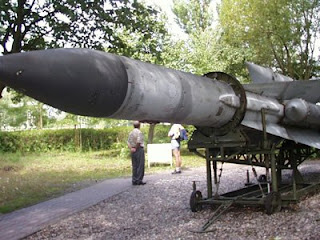The 2K12 surprised the Israelis in the 1973 Yom Kippur War. They were
used to having air superiority over the battlefield. The highly mobile
2K12 took a heavy toll on the slower A-4 Skyhawk and even the F-4 Phantom, forming a protective umbrella until they could be removed. The radar warning receivers
on the Israeli aircraft did not alert the pilot to the fact that he was
being illuminated by the radar. Once the RWRs were reprogrammed and
tactics changed, the 2K12 was no longer such a grave threat. Pilots
dubbed the 2K12 "Three Fingers of Death", in reference to the launcher's appearance.
The superior low altitude performance of the weapon, and its new CW
semi-active missile seeker resulted in a much higher success rate
compared to the earlier SA-2 and SA-3 systems. While exact losses
continue to be disputed, around 40 aircraft are usually cited as lost to
SAM shots, and the 2K12 / SA-6 proved most effective of the three
weapons.
On 19 April 1974 a MiG-23MS flown by Maj. El al-Masry is said to have shot down 2 IAF F-4Es during a mission over the Golan Heights against an Israeli offensive to destroy Syrian SAMs. He was subsequently shot down by an AAM fired by the Israelis and apparently by a friendly SA-6 battery.
The Syrians also deployed it during the conflict in Lebanon
in mid-1982 against the IAF, but this responded early to the SAM threat
in the Beqaa Valley by launching Operation Mole Cricket 19 in which
several SA-6, along with SA-2s and SA-3s were destroyed in a single day.
The system was deployed by Libya during the border dispute with Chad
and proved a threat for French aircraft, however on January 7, 1987
these were successful in destroying an SA-6 radar site in the Faya Largeau area with SEPECAT Jaguars armed with Martel anti-radiation missiles.
In March, the Chadian rebels captured Ouadi Doum air base
and captured practically the whole heavy equipment used for the defense
of this airfield intact. Most of this equipment was transported to
France and the USA in the following days, but some SA-6s remained in
Chad.
With this catastrophe, the Libyan occupation of the northern Chad –
and the annexation of the Aouzou Strip – was over: by 30 March, also the
bases at Faya Largeau and Aouzou had to be abandoned. The LARAF now has
got a completely different task: its Tu-22Bs
were to attack the abandoned bases and destroy as much equipment left
there as possible. First such strikes were flown in April, and they
continued until the 8 August 1987, when two Tu-22Bs which tried to
strike Aouzou, were ambushed by a captured SA-6 battery used by the
Chadian Army, and one of the bombers shot down.
A USAF F-16 (serial 87-228) was shot down on January 19, 1991 by an SA-6. It was combat loss number 10 in Operation Desert Storm.
The pilot, Captain Harry 'Mike' Roberts, ejected safely, but was taken
prisoner. The aircraft was on a mission to attack the Air Defense
Headquarters Building in Baghdad. It had flown 4 combat missions before
being lost.. Two days before, a B-52G was damaged by a SAM which could have been an SA-6 or an SA-3.
In any case, the SA-6 threat was largely controlled by Allied EW
assets, but the older SA-2 and SA-3 missile systems shot down several
allied aircraft.








没有评论:
发表评论